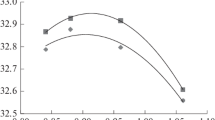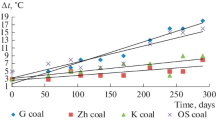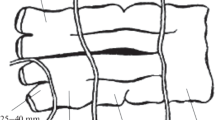Abstract
There is great scope for energy conservation in iron production. It is shown that blast furnaces and coke plants are the greatest consumers of energy and carbon in the steel industry. There are not even any optional guidelines for the calorific value of blast-furnace coke produced in Ukraine or elsewhere. Existing formulas for the calorific value of liquid and solid fuels do not permit prediction of the calorific value of blast-furnace coke with sufficient accuracy. The lack of reliable data regarding the influence of raw materials and production factors on the calorific value of blast-furnace coke prevents the identification of practical methods for its improvement.

Similar content being viewed by others
REFERENCES
Antonov, A.V., Coke quality and coking technology based on a deeper understanding of coke behavior in a blast furnace, Nov. Chern. Metall. Rubezhom, 2017, no. 1, pp. 6–11.
Li, K., Barati, M., Zhang, J., et al., Advanced coke quality characterization and cokemaking techniques based on in depth understanding of coke behavior inside blast furnace, Proc. Iron & Steel Technology Conf. AISTech, May 16–19, 2016, Pittsburgh, 2016, pp. 273–283.
Monaghan, B.J., Drain, P.B., Chapman, M.W., and Nightingale, R.J., Reactivity of coke ash on aluminosilicate blast furnace hearth refractories, ISIJ Int., 2014, vol. 54, pp. 810–819.
Guo, Z. and Fu, Z., Current situation of energy consumption and measures taken for energy saving in the iron and steel industry in China, Energy, 2010, vol. 35, pp. 4356–4360.
Braginskii, A.M., Integrirovannye energosberegayushchie tekhnologii v proizvodstve chuguna (Integrated Energy Saving Technologies in Cast Iron Production), Kharkov: Kollegium, 2011.
Li, K., Zhang, J., Liu, Z., Wang, T., et al., Zinc accumulation and behavior in tuyere coke, Metall. Mater. Trans. B, 2014, vol. 45, pp. 1581–1588.
Meng, Q., Achievements of cokemaking industry and their supports to iron and steel industry in China, Proc. 6th Int. Congr. on the Science and Technology of Ironmaking (ICSTi), Rio de Janeiro, 2012, pp. 520–531.
Gulyaev, V., Barsky, V., and Rudnitskii, A., European quality requirements on blast-furnace coke, Coke Chem., 2012, vol. 55, pp. 372–376.
Balaeva, Ya.S., Miroshnichenko, D.V., Kaftan, Yu.S., and Tyutyunnikov, Yu.B., Forecast of the maximum calorific value of coal, Uglekhim. Zh., 2014, nos. 5–6, pp. 3–13.
Drozdnik, I.D., Kaftan, Yu.S., Toryanik, E.I., et al., Influence of the composition of coal charge and coking conditions on the calorific value of commercial classes of coke on plants in Ukraine, Koks Khim., 1996, no. 8, pp. 21–23.
Drozdnik, I.D., Shul’ga, I.V., Miroshnichenko, D.V., et al., Evaluation of calorific value of commercial classes of coke, Uglekhim. Zh., 2010, nos. 5–6, pp. 22–26.
GOST (State Standard) 147-95: Solid Mineral Fuel, Determination of the Highest Combustion Heat and Calculation of the Lowest Combustion Heat, Moscow: Izd. Standartov, 1996.
DSTU (State Standard) ISO 1928:2006: Solid Mineral Fuels—Determination of Gross Calorific Value by the Bomb Calorimetric Method, and Calculation of Lowest Calorific Value, Kiev: Derzhspozhivstandart, 2008, p. 40.
Basu, P., Biomass Gasification and Pyrolysis, Amsterdam: Elsevier, 2010.
Balaeva, Ya.S., Miroshnichenko, D.V., Kaftan, Yu.S., and Kotlyarov, E.T., Influence of coal properties on the gross calorific value and maximum moisture content, Coke Chem., 2018, vol. 61, no. 1, pp. 4–11.
Balaeva, Ya.S., Miroshnichenko, D.V., and Kaftan, Yu.S., Forecast of the gross calorific value of coking coals, Solid Fuel Chem., 2007, vol. 51, no. 3, pp. 141–146.
Balaeva, Ya.S., Miroshnichenko, D.V., and Kaftan, Yu.S., Predicting the classification characteristics of coal. Part 3. Gross calorific value of dry, ash-free coal, Coke Chem., 2016, vol. 59, no. 4, pp. 123–131.
Miroshnichenko, D.V. and Ulanovskii M.L., Compositions of coals and anthracites as bases for modeling their properties, Koks Khim., 2003, no. 4, pp. 3–7.
Miroshnichenko, D.V. and Balaeva, Ya.S., Comparison of methods of predicting the higher thermal combustion of coal, Coke Chem., 2011, vol. 54, no. 11, pp. 398–402.
TU U 322-00190443-114-96. Koks domennyi. Tekhnicheskie ulsoviya (TU U 322-00190443-114-96: Blast Furnace Coke, Specification), Kharkov: Khar’k. Koksovyi Zavod, 1996.
Al-Haj Ibrahim, H., Determination of the calorific value of Syrian delayed petroleum coke, Int. J. Petrochem. Sci. Eng., 2016, vol. 1, no. 3, pp. 1–6.
Retanakuakangwan, S. and Tangjitsitcharoen, S., Comparison of metallurgical coke and lignite coke for power generation in Thailand, IOP Conf. Ser.: Mater. Sci. Eng., 2017, vol. 191, pp. 1–5.
Parikh, J., Channiwala, S.A., and Ghosal, G.K., A correlation for calculating HHV from proximate analysis of solid fuels, Fuel, 2005, vol. 84, no. 5, pp. 487–494.
TU U 19.1-001190443-065:2015. Koks domennyi OOO “Metinvest Khloding” (TU U 19.1-001190443-065:2015: Blast-Furnace Coke of Metinvest Holding), Kharkov: Ukr. Gos. Nauchno-Issled. Uglekhim. Inst., 2015.
Nesterenko, L.L., Biryukov, Yu.V., and Lebedev, V.A., Osnovy khimii i fiziki goryuchikh iskopaemykh (Fundamentals of Chemistry and Physics of Combustible Minerals), Kiev: Vishcha Shkola, 1987.
Ulanovskii, M.L., Sheshnev, V.G., Grabovskaya, E.B., et al., Relationship of calorific value with elementary composition of coal, Khim. Tverd. Topl. (Moscow), 1989, no. 6, pp. 62–67.
Ulanovskii, M.L., Men’shikova, S.D., and Miroshnichenko, D.V., Calculation of calorific value of solid fuel, Uglekhim. Zh., 2001, nos. 5–6, pp. 12–15.
Channiwala, S.A. and Parikh, P.P., A unified correlation for estimating HHV of solid, liquid and gaseous fuels, Fuel, 2002, vol. 81, pp. 1051–1063.
Boie, W., Fuel technology calculations, Energietechnik, 1953, vol. 3, pp. 309–316.
Buckley, T.J. and Domalski, E.S., Evaluation of data on higher heating values and elemental analysis for refuse derives fuels, Proc. 1988 National Waste Processing Conf., New York: Am. Soc. Eng., 1988.
Gumz W. // Chemical Abstracts. 1939. Vol. 33. P. 6556.
Coal Conversion Systems Technical Data Book, ERDA No. FE-2286-32, Springfield, VA: Inst. Gas Technol., 1978.
Mott, R.A. and Spooner, C.E., The calorific value of carbon in coal: the Dulong relationship, Fuel, 1940, vol. 19, nos. 10–11, pp. 226–251.
Selvig, W.A. and Gibson, I.H., Calorific value of coal, in Chemistry of Coal Utilization, Lowry, H.H., Ed., New York: Wiley, 1945, vol. 1, pp. 139.
Seyler, C.A., Petrology and the classification of coal: Parts I and II, Proc. S. W. Inst. Eng., 1938, vol. 53, pp. 254–327.
Strache, H. and Lant, R., Kohlenchemie, Leipzig: Akad. Verlagsgesellschaft, 1924, p. 476.
Sumegi, L., Chem. Abstr., 1940, vol. 34, p. 1459.
Vondrácek, R., Brennstoff-Chem., 1934, vol. 8, pp. 22–23.
Zhu, X. and Venderbosch, R., A correlation between stoichiometric ratio of fuel and its higher heating value, Fuel, 2005, vol. 84, pp. 1007–1010.
Chang, Y.C., Estimating heat of combustion for waste material, Pollut. Eng., 1979, vol. 29.
DSTU (State Standard) 4083-2002: Coals and Anthracite for Pulverized Burning at Thermal Power Plants, Specifications, Kyiv: Derzhstandart Ukrainy, 2002.
Author information
Authors and Affiliations
Corresponding authors
Additional information
Translated by Bernard Gilbert
About this article
Cite this article
Miroshnichenko, I.V., Miroshnichenko, D.V., Shulga, I.V. et al. Calorific Value of Coke. 1. Prediction. Coke Chem. 62, 143–149 (2019). https://doi.org/10.3103/S1068364X19040057
Received:
Revised:
Accepted:
Published:
Issue Date:
DOI: https://doi.org/10.3103/S1068364X19040057




